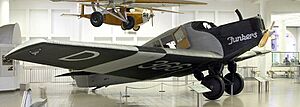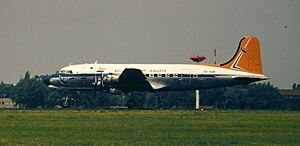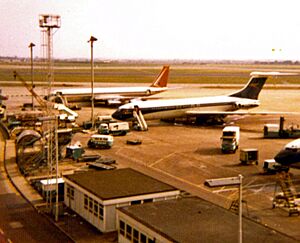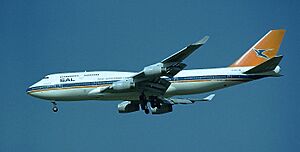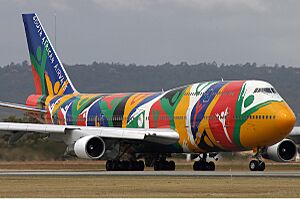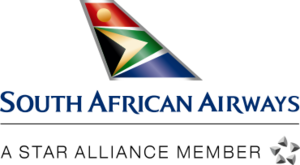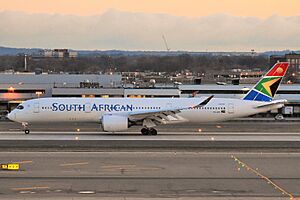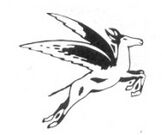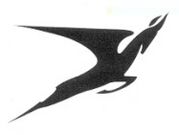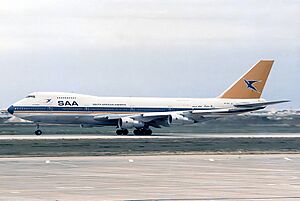South African Airways facts for kids

A South African Airways Airbus A340
|
|
| Founded | 24 July 1929 (as Union Airways) |
|---|---|
| Hubs | O. R. Tambo International Airport |
| Secondary hubs | Cape Town International Airport |
| Frequent-flyer program | Voyager |
| Alliance | Star Alliance |
| Subsidiaries |
|
| Fleet size | 20 |
| Destinations | 15 |
| Parent company | Government of South Africa |
| Headquarters | Airways Park, O. R. Tambo International Airport, Johannesburg, Gauteng, South Africa |
| Key people | |
| Revenue | |
| Operating income | |
| Profit | |
| Total assets | |
South African Airways (SAA) is the main airline of South Africa. It started in 1929 as Union Airways and changed its name to South African Airways in 1934. The airline's main office is at O. R. Tambo International Airport in Johannesburg. SAA flies to 13 places in Africa and two international cities: Perth, Australia and São Paulo, Brazil. In April 2006, SAA joined Star Alliance, becoming the first African airline to join a major airline group.
SAA faced money problems and stopped flying in 2020. In June 2021, the South African government decided to sell part of SAA to a group called the Takatso Consortium. The government would keep 49% of the airline, and the consortium would own 51%. However, this deal was later cancelled, and SAA is now fully owned by the state again. SAA got its flying license back on August 4, 2021, with a fleet of eight planes.
The airline started flying again on September 23, 2021. Even though it hadn't flown for 18 months, Skytrax named SAA the second-best airline in Africa in 2021. Since then, SAA has grown steadily. It now has 20 aircraft, flies to 15 destinations, and employs about 2,000 people.
Contents
History of South African Airways
How SAA Started and Grew

South African Airways began on February 1, 1934. This happened after the South African government bought Union Airways. SAA took over Union Airways' staff and planes, including several Junkers F.13 aircraft. The airline then became part of the South African Railways and Harbours Administration.
In 1935, SAA bought another airline called Suidwes Lugdiens (now Air Namibia). SAA also ordered three Junkers Ju 52/3m planes. These planes could carry 14 passengers and helped SAA start more flights between cities like Durban and Johannesburg. On July 1, 1935, SAA moved its main operations to Rand Airport, as Johannesburg was becoming a major aviation hub.
SAA grew quickly, but it also had its first accident in July 1937. A new Ju 52 crashed after takeoff, and one person died. By May 1940, SAA had carried many passengers and cargo. However, all flights were stopped on May 24, 1940, because of World War II.
After the war, SAA started flying more often and opened new routes. They used planes like the Lockheed Lodestars for domestic flights. On November 10, 1945, SAA made its first flight to Europe, landing in England. Later, they used Douglas DC-4 and Lockheed Constellation planes for international routes.
Growing in the Mid-1900s
On November 10, 1945, SAA launched its first long-distance service, called the Springbok Service. This flight to England took three days. The Douglas DC-4 Skymaster started flying between Johannesburg and Cape Town in May 1946. This was also when Douglas DC-3 planes began flying the Johannesburg–Durban route.
As more Skymasters arrived, SAA's fleet and staff grew. In September 1946, SAA introduced air hostesses on domestic flights, and later on international flights. In 1948, Palmietfontein Airport became SAA's main hub. SAA also started showing movies on its Skymaster planes in June 1948. In August 1950, SAA received its first planes with pressurized cabins, the Lockheed Constellations. These planes flew to London's Heathrow airport.
The Jet Age Begins
The age of jet planes arrived in South Africa on May 3, 1952, when a BOAC de Havilland Comet landed in Palmietfontein. SAA then rented two Comets from BOAC in October 1953. These planes had both BOAC and SAA logos and were flown by SAA crews.
In 1956, SAA introduced the Douglas DC-7B, which was a very fast propeller plane. SAA used it for flights between Johannesburg and London with only one stop, making the journey much faster. In November 1957, SAA started the Wallaby Route to Perth, Australia.
SAA ordered three Boeing 707-320 jet planes in February 1958. The first one arrived in July 1960. On October 1, 1960, the Boeing 707 began flying on the main Springbok Service, cutting the flight time to London to just 13 hours. The 707s also brought a new look for SAA planes, with an orange tail and blue and white designs. In 1967, a 707 replaced the DC-7B on the Wallaby Route, extending it to Sydney. Flights to New York, stopping in Rio de Janeiro, began in February 1969.
During this time, many African countries did not allow South African airlines to fly over their airspace. This meant SAA planes had to take longer routes. By 1967, older planes like the Skymasters and Constellations were being replaced by the Boeing 727 jet. The 727 was chosen because it could fly well from airports like Johannesburg, which is high up and hot.
On March 13, 1968, SAA ordered five Boeing 747-200B "Jumbo Jets." The first one arrived in October 1971 and became very popular. SAA eventually had 23 of these large planes, including the Boeing 747SP, which could fly very long distances. The 747SP was important because it helped SAA fly around countries that denied them airspace.
Expanding Routes and Fleet

SAA started flying to Asia in June 1974, with Boeing 707 flights to Hong Kong. In 1980, SAA began nonstop flights to Taipei using a Boeing 747SP.
Because some African countries still did not allow SAA to fly over their land, SAA planes had to fly around the 'bulge' of Africa, adding thousands of kilometers to their journeys. On December 26, 1980, the last Boeing 707 flight for SAA took place. It was replaced by the Airbus A300, a wide-body plane. The older 727s were replaced by the more fuel-efficient Boeing 737 by 1983.
Changes After Apartheid

After apartheid ended in 1990, SAA started flying to many new places in Africa and Asia. Flights to New York City began again in November 1991, and SAA planes could finally fly over Egypt and Sudan. The airline also started flights to Milan and brought back services to Athens.
In January 1991, SAA received its first Boeing 747-400 planes. These planes could fly nonstop from South Africa to the east coast of the United States. SAA also got the world's first commercial fly-by-wire airliner, the Airbus A320, for flights within South Africa and nearby regions. Boeing 767s arrived in August 1993 and flew to African, Southern European, and Middle Eastern destinations.
In 1992, SAA started flights to Miami and returned to Australia, flying nonstop to Perth and Sydney. SAA also began working with other airlines like American Airlines and Air Tanzania. On domestic flights, SAA greeted passengers in four languages: English, Afrikaans, Zulu, and Sotho.
In April 1994, South African Express (SA Express), a smaller airline that connected to SAA flights, began operating. SAA owned a part of SA Express. In 1995, Lufthansa started sharing flights with SAA. By April 1996, South African Airways had 11,100 employees and 48 aircraft, flying to 34 destinations.
New Look and Challenges
In 1997, SAA changed its look. It replaced the old "Flying Springbok" symbol and the orange, white, and blue colors with a new design based on the new South African flag. One of SAA's 747-300s, named Ndizani, was painted in bright colors to represent the new "rainbow nation." This plane took South African athletes to the 1996 Summer Olympics in Atlanta.
In 1998, a new CEO, Coleman Andrews, was hired. He made many changes to improve the airline, which was struggling with delays and unhappy customers. Under his leadership, SAA's value grew a lot. In 1999, Transnet, SAA's parent company, sold 20% of SAA to Swissair. However, the South African government bought these shares back in 2002.
In 2000, SAA ordered 21 Boeing 737-800s for shorter flights. In 2002, SAA made a big order for new Airbus planes, including A319s, A320s, and A340s. This was a good time to buy planes because many airlines were not ordering new ones after the September 11 attacks. SAA also tried to buy a part of Air Tanzania to expand in East Africa, but this deal did not work out.
In 2004, SAA applied to join Star Alliance, a group of airlines that work together. SAA became a full member in April 2006, the first African airline to do so.
Changes and Financial Struggles
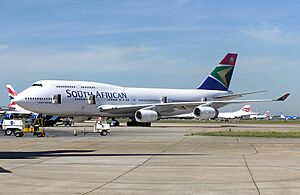
The South African government planned to separate SAA from its parent company, Transnet. SAA joined Star Alliance on April 10, 2006. To celebrate, two of its planes were painted in Star Alliance colors.
In May 2007, SAA started a plan to become profitable again. This involved making changes like creating separate companies for different parts of the business and reducing the number of managers. These changes were expected to save a lot of money.
In February 2010, Siza Mzimela became SAA's first female CEO. She had previously led SAA's partner airline, South African Express. At the end of 2010, SAA stopped using its Boeing 747-400 planes permanently and leased two Airbus A340-300s instead.
Financial Difficulties and Restarting Flights
In 2012, SAA added new Airbus A320-200 planes to its fleet. On August 16, 2012, SAA stopped its Cape Town-London route after 20 years due to fewer passengers and higher airport fees. SAA also started flights to Beijing, China, in January 2012. However, flights to Buenos Aires, Beijing, and Mumbai later ended. By June 2015, only a few long-haul routes were making money.
By September 2017, SAA began reducing its fleet and cutting flights. The airline was facing serious financial problems and needed money from the government to pay its debts. On December 5, 2019, the South African government announced that SAA would enter "business rescue," a process to try and save the company from bankruptcy. SAA had not made a profit since 2011.
In January 2020, SAA stopped several routes to save money. In February 2020, it introduced new Airbus A350-900s to modernize its long-distance fleet. However, in April 2020, the government said it would stop funding the airline due to the COVID-19 pandemic. This led to fears that SAA would close down.
By May 1, 2020, all SAA staff were on unpaid leave. The airline had lost a lot of money and received billions in government help over the years. On May 2, 2020, the government announced that SAA would stop operations, and a new airline would be created. However, a legal dispute delayed this. In July, creditors agreed to a plan to restructure the airline, helping it avoid closing completely.
In September 2020, SAA stopped all flights again until more money could be found. In October 2020, the government gave SAA R10.5 billion to help it recover. During 2020, SAA returned many of its leased planes, including Airbus A319s, A320s, A330s, A340s, and the new A350s.
By February 2021, the government was talking with three possible investors to bring the airline back to life with fewer employees. SAA had lost a total of R32 billion between 2008 and 2020.
SAA Relaunches and Grows
In June 2021, the South African government decided to give up its main ownership of SAA. They chose the Takatso Consortium to own 51% of the airline, with the government keeping 49%. The consortium includes Harith General Partners and Global Airways. The Minister of Public Enterprises, Pravin Gordhan, announced that SAA would receive a R3 billion investment from the new partners.
In October 2022, SAA added two more Airbus A320-200 planes and started new flights from Johannesburg to places like Victoria Falls, Malawi, and Windhoek, Namibia. On October 31, 2023, SAA restarted flights to São Paulo in Brazil, its first international route since the pandemic began. SAA also resumed flights to Perth, Australia, in April 2024. As of August 2025, SAA has increased its Perth flights to four times a week, with plans to increase to five by late January 2025.
SAA Headquarters
South African Airways' main office is called Airways Park. It is located at O. R. Tambo International Airport in Kempton Park, near Johannesburg. The building was finished in March 1997 and cost R70 million. It is a large building that connects to three older buildings.
SAA's head office used to be in Durban and then at Rand Airport in Germiston. Before moving to Airways Park, the airline's main office was in the Airways Towers in Johannesburg.
SAA Emblems and Logos
South African Airways used the "Flying Springbok" logo from its start in 1934 until 1997. Even though the logo changed, the word "Springbok" is still used as the airline's radio callsign.
Controversies and Challenges
Fair Competition Concerns
In 2007, SAA paid R55 million to the Competition Commission of South Africa for unfair business practices, like trying to control prices. This was in addition to an earlier R45 million fine for trying to stop travel agents from working with other airlines.
Some other airlines, like Kulula, have said that it is hard to compete with SAA because SAA gets money from the government. They argue that this makes it unfair for private airlines that do not receive such funding.
Workplace Issues
SAA has faced accusations of unfair hiring practices in the past. For example, in one instance, a trade union called Solidarity took legal action against SAA for rejecting white cadet pilots based on their race, even if they met the requirements. SAA stated that it needed to meet targets for hiring people from previously disadvantaged backgrounds, but also that it hired white male pilots when needed. The policy was later changed.
During the time of former President Jacob Zuma, the SAA board faced accusations of improper activities. These issues were widely seen as a reason for SAA's serious financial problems. One person, Dudu Myeni, who was the chairperson of the SAA board, was later declared a "delinquent director" by a court. This meant she was banned from holding any directorship position for life due to her actions while leading SAA.
In November 2019, SAA experienced a strike by its workers' unions. The strike lasted for about a week and cost the airline a lot of money each day.
Leaders of SAA
| Term started | Term ended | Name | Notes |
|---|---|---|---|
| 1975 | 1977 | Salomon Pienaar | |
| 1977 | 1982 | Eddie Smuts | |
| 1982 | 1983 | Frans Swarts | |
| 1983 | 1993 | Gerrit van der Veer | |
| 1993 | 1998 | Michael Myburgh | |
| 1998 | 2001 | Coleman Andrews | |
| 2001 | 2004 | Andre Viljoen | |
| 2004 | 2009 | Khaya Ngqula | |
| 2009 | 2010 | Chris Smythe | (acting) |
| 2010 | 2012 | Siza Mzimela | |
| 2012 | 2013 | Vuyisile Kona | (Chairman / acting CEO) |
| 2013 | 2013 | Nico Bezuidenhout | (acting) |
| 2013 | 2014 | Monwabisi Kalawe | |
| 2014 | 2015 | Nico Bezuidenhout | (acting) |
| 2015 | 2015 | Thuli Mpeshe | (acting) |
| 2015 | 2017 | Musi Zwane | (acting) |
| 2017 | 2019 | Vuyani Jarana | |
| 2019 | 2020 | Zukisa Ramasia | (acting) |
| 2020 | 2020 | Philip Saunders | (interim) |
| 2021 | 2022 | Thomas Kgokolo | (interim) |
| 2022 | Incumbent | John Lamola |
SAA Destinations
As of January 2024, South African Airways flies to 17 places in 12 countries across Africa, Australia, and South America. Within South Africa, SAA flies to three cities. In the past, SAA had a large network of domestic and regional flights through its partners like Mango Airlines, Airlink, and South African Express.
Airlines SAA Works With
South African Airways shares flights with many other airlines. This means you can sometimes book a flight with SAA, but actually fly on a plane from one of these partner airlines:
- Africa World Airlines
- Air Canada
- Air China
- Air Mauritius
- Air New Zealand
- Air Seychelles
- All Nippon Airways
- Asiana Airlines
- Brussels Airlines
- Egyptair
- Ethiopian Airlines
- Gol Airlines
- JetBlue
- Kenya Airways
- LAM Mozambique Airlines
- Lufthansa
- RwandAir
- Scandinavian Airlines
- Singapore Airlines
- Swiss International Air Lines
- TAAG Angola Airlines
- TAP Air Portugal
- United Airlines
- Virgin Australia
SAA also has agreements with other airlines like Air Burkina, APG Airlines, Hahn Air, and Hawaiian Airlines to help passengers connect between flights.
SAA Aircraft Fleet
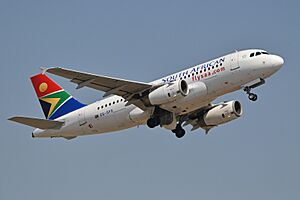
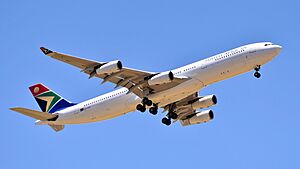
Current Aircraft
As of April 2025[update], South African Airways uses only Airbus planes. Here are the types of aircraft they have:
| Aircraft | In service | Orders | Passengers | Notes | ||
|---|---|---|---|---|---|---|
| C | Y | Total | ||||
| Airbus A320-200 | 14 | — | 24 | 114 | 138 | |
| 8 | 150 | 158 | ||||
| — | 186 | 186 | ||||
| Airbus A330-300 | 2 | 2 | 46 | 203 | 249 | 2 Still to be delivered |
| Airbus A340-300 | 2 | — | 38 | 215 | 253 | |
| Total | 18 | 2 | ||||
Note: All Boeing 737-800 are rented from Sun Express and will be returned during the winter months.
Past Aircraft Used by SAA
South African Airways has used many different types of aircraft throughout its history. Here are some of them:
| Aircraft | Total | Introduced | Retired | Notes |
|---|---|---|---|---|
| Airbus A300B2 | 4 | 1976 | 2001 | |
| Airbus A300B4 | 4 | 1981 | 2001 | |
| Airbus A300C4 | 1 | 1982 | 2000 | |
| Airbus A319-100 | 10 | 2004 | 2023 | |
| Airbus A320-200 | 7 | 1991 | 2002 | |
| 11 | 2013 | 2020 | ||
| Airbus A330-200 | 5 | 2002 | 2004 | Rented from other airlines. |
| 6 | 2011 | 2020 | ||
| Airbus A340-200 | 6 | 2003 | 2014 | |
| Airbus A340-600 | 9 | 2002 | 2021 | |
| Airbus A350-900 | 4 | 2019 | 2020 | 2 went to Air Mauritius 2 went to Avolon |
| Airspeed AS.6 Envoy | 4 | 1936 | 1938 | |
| Avro 685 York | 8 | 1945 | 1947 | |
| Boeing 707-320 | 11 | 1960 | 1980 | ZS-EUW crashed as Flight 228. |
| Boeing 727-100 | 6 | 1965 | 1982 | |
| Boeing 727-100C | 3 | 1967 | 1982 | |
| Boeing 737-200 | 29 | 1968 | 2006 | |
| Boeing 737-200F | 2 | 1981 | 2013 | |
| Boeing 737-300F | 3 | 2007 | 2020 | |
| Boeing 737-800 | 21 | 2000 | 2018 | Sixteen planes were moved to Mango Airlines. |
| Boeing 747-200B | 5 | 1971 | 2004 | ZS-SAN is kept at the South African Airways Museum Society at Rand Airport |
| Boeing 747-200M | 2 | 1980 | 1994 | ZS-SAS crashed as Flight 295. |
| Boeing 747-200F | 2 | 1995 | 2000 | ZS-SAR was later damaged beyond repair in a crash while flying for another airline. |
| Boeing 747-300 | 6 | 1983 | 2004 | |
| Boeing 747-400 | 8 | 1991 | 2010 | |
| Boeing 747SP | 6 | 1976 | 2003 | ZS-SPC is kept at the South African Airways Museum Society at Rand Airport. |
| Boeing 767-200ER | 3 | 1993 | 2004 | |
| de Havilland DH.60 Gypsy Moth | 1 | 1934 | 1937 | |
| de Havilland DH.104 Dove | 2 | 1947 | 1952 | |
| de Havilland DH.106 Comet | 2 | 1953 | 1954 | Rented from BOAC. G-ALYY crashed as Flight 201. |
| Douglas DC-3 | 8 | 1946 | 1970 | |
| Douglas DC-4 | 7 | 1946 | 1967 | |
| Douglas DC-7 | 4 | 1956 | 1967 | |
| Hawker Siddeley HS 748 | 3 | 1970 | 1983 | |
| Junkers F.13 | 4 | 1934 | 1940 | |
| Junkers Ju 52/3m | 15 | 1934 | 1940 | |
| Junkers Ju 86 | 18 | 1937 | 1940 | |
| Junkers W.34 | 1 | 1934 | 1937 | |
| Lockheed Constellation | 4 | 1950 | 1964 | |
| Lockheed L-18 Lodestar | 21 | 1944 | 1955 | |
| Vickers VC.1 Viking | 8 | 1947 | 1951 | |
| Vickers Viscount | 8 | 1958 | 1971 |
SAA Passenger Services
Onboard Services
- Business Class
On SAA's Airbus A330-300 and A340-300 planes, business class seats are very spacious. They are arranged in a 2-2-2 layout. Passengers get a welcome pack, a duvet, a full-size pillow, and a personal screen to watch movies and shows. On domestic and regional flights, SAA uses Airbus A320-200 planes. Their business class seats are also comfortable, in a 2-2 layout.
- Economy Class
SAA's Airbus A330 and A340 economy class seats are arranged in a 2-4-2 layout. Passengers receive a welcome pack, a blanket, a full-size pillow, and a personal screen for entertainment. The Airbus A320 economy class seats are also comfortable.
Frequent Flyer Program
Voyager is SAA's program for frequent flyers. Members earn "Tier Miles" by flying on certain flights to reach higher levels like Blue, Silver, Gold, Platinum, and Lifetime Platinum. They also earn "Base Miles" which can be used for rewards like free flights. The program partners with 32 other airlines and many businesses.
Airport Lounges
SAA has lounges at airports around the world. These lounges are special waiting areas for SAA Business and First Class passengers. Also, customers with certain high-level bank cards can access these lounges.
Accidents and Incidents
- On June 16, 1937, a Junkers Ju 52/3m plane was destroyed by fire after crashing on takeoff at Port Elizabeth Airport. No one died, but passengers were injured.
- On October 16, 1937, a Junkers W34 fi mail plane crashed and was badly damaged.
- On March 28, 1941, a Lockheed Model 18 Lodestar crashed at Elands Bay, South Africa. Everyone on board died.
- On January 5, 1948, a Lockheed Model 18 Lodestar landed too far down the runway at Palmietfontein. The plane was damaged, but there were no deaths.
- On October 15, 1951, a Douglas DC-3 plane crashed into Mount Ingeli near Kokstad. Seventeen people died.
- On September 15, 1952, a Douglas DC-3 was damaged while trying to land at an unlit airport in Carolina, South Africa. No one was killed.
- On April 8, 1954, a de Havilland Comet I (Flight 201) crashed off the coast of Italy. All 21 people on board died. The plane was rented from another airline.
- On October 29, 1960, a Boeing 707-344A (Flight 218) landed without its wheels at Nairobi Airport after damaging its landing gear. No one was hurt.
- On March 6, 1962, a Douglas DC-3 (Flight 512) crashed into a mountainside in South Africa. The pilot and co-pilot died, but passengers and cabin staff survived.
- On June 30, 1962, a Douglas DC-4 was in a mid-air collision with a military training plane near Durban airport. The military plane crashed, but the SAA plane landed safely.
- On March 13, 1967, a Vickers Viscount 818 (Flight 406) crashed into the sea near Kayser's Beach. All 25 people on board died.
- On April 20, 1968, a Boeing 707-344C (Flight SA228) crashed near Windhoek, South West Africa (now Namibia). 123 people died.
- On May 24, 1972, a Boeing 727-100 was hijacked. Two people took control of the plane using dynamite sticks. The pilot tricked them into landing in Malawi, where the passengers and crew escaped. The hijackers were arrested.
- On November 28, 1987, a Boeing 747-200B Combi (Flight 295) crashed in the Indian Ocean after a fire in the cargo area. All 159 people on board died.
- On June 17, 2006, on South African Airways Flight 322, a Boeing 737-800 was involved in a hostage situation. A man tried to enter the cockpit, but he was stopped. The plane returned to Cape Town, and the suspect was arrested.
- On November 6, 2018, an Airbus A340-600 (Flight SA260) had a serious incident over Switzerland. The plane went too fast, and the pilots temporarily lost control. The investigation found that the pilots were not properly trained for such events.
- On February 24, 2021, an Airbus A340-600 (Flight SA4272) had an issue during takeoff from Johannesburg on its way to Brussels. The plane's safety system activated to prevent it from stalling.
- On November 12, 2022, an Airbus A320-200 collided with a parked FlySafair Boeing 737-800 at O. R. Tambo International Airport. No passengers were on board, but both planes were damaged.
See also
 In Spanish: South African Airways para niños
In Spanish: South African Airways para niños
- Airlines of Africa
- Airlink
- Mango
- South African Express
- Transport in South Africa


